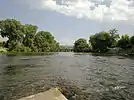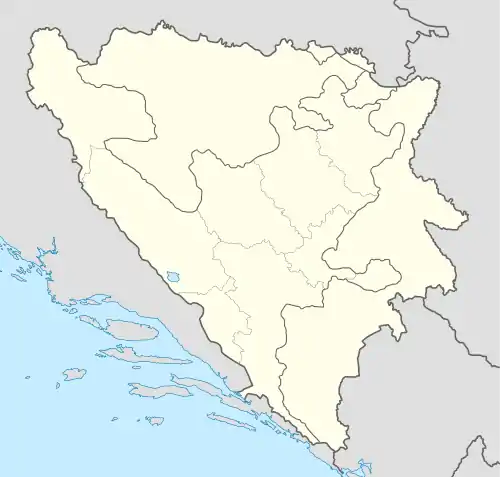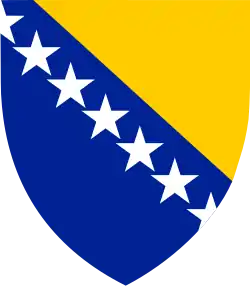Sanski Most
Sanski Most (Serbian Cyrillic: Сански Мост, pronounced [sâːnskiː mɔ̂ːst]) is a town and municipality located in the Una-Sana Canton of the Federation of Bosnia and Herzegovina, an entity of Bosnia and Herzegovina. It is situated on the banks of the Sana River in northwestern Bosnia and Herzegovina, in the region of Bosanska Krajina, between Prijedor and Ključ. As of 2013, it has a population of 41,475 inhabitants.
Sanski Most
Сански Мост | |
|---|---|
Town and municipality | |
     .jpg.webp)  | |
 Coat of arms | |
 Sanski Most Location of Sanski Most | |
| Coordinates: 44°46′N 16°40′E | |
| Country | |
| Entity | |
| Canton | Una-Sana Canton |
| Subdivisions | 75 |
| Government | |
| • Mayor | Faris Hasanbegović (SDA) |
| Area | |
| • Total | 781 km2 (302 sq mi) |
| Population (2013 Census) | |
| • Total | 41,475 |
| • Density | 53.10/km2 (137.5/sq mi) |
| Time zone | UTC+1 (CET) |
| • Summer (DST) | UTC+2 (CEST) |
| Area code(s) | +387 37 |
| Website | www |
Geography
It is located on the Sana River in Bosanska Krajina, between Prijedor and Ključ. Administratively it is part of the Una-Sana Canton of the Federation of Bosnia and Herzegovina.
History
In 1878 the little town (varošica) of Sanski Most was described as Muslim by Croatian historian Vjekoslav Klaić.[1] From 1929 to 1941, Sanski Most was part of the Vrbas Banovina of the Kingdom of Yugoslavia.
During World War II it was part of the Axis Independent State of Croatia (NDH), where the fascist Ustaše regime committed the Genocide of the Serbs and the Holocaust. At the beginning of May 1941 in several villages south-east of Sanski Most (Kijevo, Tramošnja, Kozica, etc.) the first armed conflict between the Ustaše and insurgent Serbs occurred. The event is known as the Đurđevdan uprising. In August 1941 on the Eastern Orthodox Elijah's holy day, who is the patron saint of Bosnia and Herzegovina, between 2,800 and 5,500 Serbs from Sanski Most and the surrounding area were killed and thrown into pits which have been dug by victims themselves.[2] The State Anti-fascist Council for the National Liberation of Bosnia and Herzegovina (ZAVNOBiH) held its second meeting from 30 June to 2 July 1944 in the town; it declared the equality of Muslims (Bosniaks), Serbs and Croats.
During the Bosnian War, the town was controlled by the Army of Republika Srpska (Bosnian Serbs) and remained under its control until October 1995 when the Army of Bosnia and Herzegovina took over it during Operation Sana shortly before the end of the war.
In 1996, Serb-inhabited Oštra Luka was split from Sanski Most and ceded to the Republika Srpska entity.
Demographics
Population
| Population of settlements – Sanski Most municipality | ||||||
|---|---|---|---|---|---|---|
| Settlement | 1961. | 1971. | 1981. | 1991. | 2013. | |
| Total | 39,483 | 62,102 | 62,467 | 60,307 | 50,421 | |
| 1 | Brdari | 539 | 443 | |||
| 2 | Čaplje | 1,420 | 1,264 | |||
| 3 | Demiševci | 498 | 440 | |||
| 4 | Donji Kamengrad | 2,344 | 2,336 | |||
| 5 | Dževar | 685 | 681 | |||
| 6 | Fajtovci | 369 | 362 | |||
| 7 | Gorice | 644 | 615 | |||
| 8 | Gornji Kamengrad | 1,387 | 1,311 | |||
| 9 | Hrustovo | 1,694 | 1,697 | |||
| 10 | Husimovci | 1,802 | 1,310 | |||
| 11 | Kijevo | 1,118 | 682 | |||
| 12 | Krkojevci | 304 | 361 | |||
| 13 | Lukavice | 606 | 486 | |||
| 14 | Lušci Palanka | 1,079 | 226 | |||
| 15 | Modra | 578 | 595 | |||
| 16 | Naprelje | 822 | 605 | |||
| 17 | Okreč | 1,104 | 1,021 | |||
| 18 | Podbriježje | 570 | 529 | |||
| 19 | Podlug | 650 | 550 | |||
| 20 | Podvidača | 679 | 275 | |||
| 21 | Poljak | 522 | 483 | |||
| 22 | Sanski Most | 8,682 | 14,027 | 17,144 | 19,745 | |
| 23 | Sasina | 1,054 | 294 | |||
| 24 | Šehovci | 960 | 880 | |||
| 25 | Skucani Vakuf | 1,321 | 1,434 | |||
| 26 | Stari Majdan | 1,212 | 762 | |||
| 27 | Tomina | 1,513 | 1,107 | |||
| 28 | Trnova | 978 | 783 | |||
| 29 | Vrhpolje | 1,840 | 2,035 | |||
Ethnic composition
| Ethnic composition – Sanski Most town | ||||||||
|---|---|---|---|---|---|---|---|---|
| 2013. | 1991. | 1981. | 1971. | |||||
| Total | 19,745 (100,0%) | 17,144 (100,0%) | 14,027 (100,0%) | 8,682 (100,0%) | ||||
| Serbs | 401 (2,37%) | 7,831 (45,68%) | 5,691 (40,57%) | 3,410 (39,27%) | ||||
| Bosniaks | 15,930 (94,19%) | 7,245 (42,26%) | 6,067 (43,25%) | 4,545 (52,34%) | ||||
| Jugoslaveni | 901 (5,255%) | 1,504 (10,72%) | 96 (1,10%) | |||||
| Croats | 177 (1,05%) | 646 (3,768%) | 523 (3,729%) | 558 (6,42%) | ||||
| Others | 405 (2,39%) | 521 (3,039%) | 242 (1,725%) | 73 (0,84%) | ||||
| Ethnic composition – Sanski Most municipality | ||||||||
|---|---|---|---|---|---|---|---|---|
| 2013. | 1991. | 1981. | 1971. | 1961. | ||||
| Total | 50,421 (100,0%) | 60,307 (100,0%) | 62,467 (100,0%) | 62,102 (100,0%) | 39,483 (100,0%) | |||
| Bosniaks | 38,344 (92,45%) | 28,136 (46,65%) | 27,083 (43,36%) | 24,839 (40,00%) | 12,350 (31.28%) | |||
| Serbs | 1,837 (4,429%) | 25,363 (42,06%) | 26,619 (42,61%) | 30,422 (48,99%) | 19,156 (48.52%) | |||
| Croats | 722 (1,741%) | 4,322 (7,167%) | 5,314 (8,507%) | 6,307 (10,16%) | 4,844 (12.27%) | |||
| Others | 572 (1,379%) | 1,239 (2,054%) | 336 (0,538%) | 213 (0,343%) | ||||
| Yugoslavs | 1,247 (2,068%) | 2,936 (4,700%) | 195 (0,314%) | 3,014 (7.63%) | ||||
| Roma | 75 (0,120%) | 12 (0,019%) | ||||||
| Montenegrins | 50 (0,080%) | 59 (0,095%) | ||||||
| Albanians | 26 (0,042%) | 22 (0,035%) | ||||||
| Slovenes | 16 (0,026%) | 23 (0,037%) | ||||||
| Macedonians | 10 (0,016%) | 8 (0,013%) | ||||||
| Hungarians | 2 (0,003%) | 2 (0,003%) | ||||||
Economy
| Employment | Male | Female | Total | Total Population | Unemployment % |
|---|---|---|---|---|---|
| 2014 | 3,384 | 1,363 | 4,747 | 50,421 | 53.91%[3] |
There are several non-governmental organisations in Sanski Most. Center for Peacebuilding, in the local language "Centar za Izgradnju Mira (CIM)" has been active in the city since 2004. The "Fenix Center", Centar Fenix provides humanitarian aid to the persons in need in the local community. The organisation "Krajiška Suza" is providing care in medical, social, psychological, cultural and existential needs of people living in and around Sanski Most. Austrian manufacturer of exhaust pipes Remus has a manufacturing facility in Sanski Most that employs around 300 people.[4][5] Sanski Most was selected as one of the most successful local communities within the UNDP project that was financed by Swiss embassy.[6]
Sport
The football club of the town is NK Podgrmeč.
Gallery
 Sana river
Sana river Hamzibey's mosque
Hamzibey's mosque Orthodox church
Orthodox church
Notable people
- Mehmed Alagić, general
- Sanjin Halimović, politician
- Milan Vukić, chess grandmaster
- Anna Ibrisagic, Swedish politician
- Enver Redžić, historian
- Kemal Malovčić, singer
- Milenko Zorić, Serbian sprint canoer, silver medalist at the 2016 Summer Olympics, World and European champion
- Vukašin Brajić, singer
- Milka Milinković, Paralympic track and field athlete, Croatia's most successful Paralympian
See also
References
- Vjekoslav Klaić (1878). Bosna: podatci o zemljopisu i poviesti Bosne i Hercegovine. Naklad. "Matice Hrvatske". p. 192.
- Mojzes, Paul (2011). Balkan Genocides: Holocaust and Ethnic Cleansing in the 20th Century. Lanham: Rowman & Littlefield. p. 75-76. ISBN 9781442206632.
- "Remus to build a new production facility in Sanski Most". www.see-industry.com. Retrieved 2020-07-18.
- "Remus Innovation will hire 300 workers in Sanski Most". Sarajevo Times. 2012-12-27. Retrieved 2020-07-18.
- Fena. "Sanski Most privlači sve više investicija i ostvaruje veliki ekonomski napredak". Radio Sarajevo. Retrieved 2020-07-18.
External links
| Wikimedia Commons has media related to Sanski Most. |
